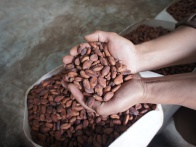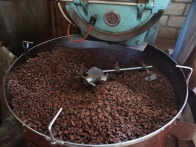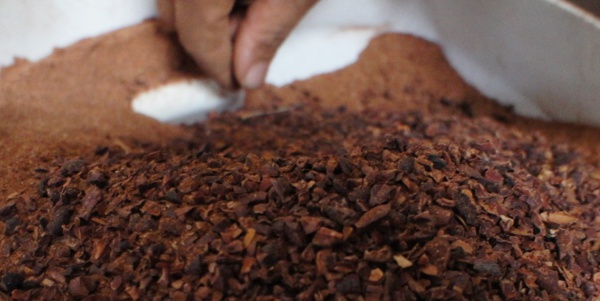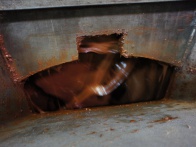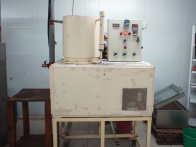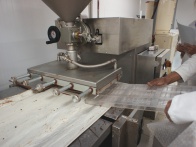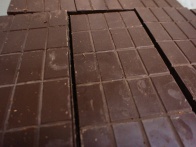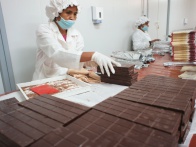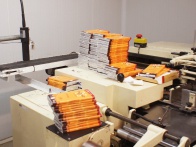Difference between revisions of "Cinagra"
CampMaster (talk | contribs) |
CampMaster (talk | contribs) |
||
| Line 5: | Line 5: | ||
|colspan="3" | [[File:Cinagra 068.jpg|600px]] | |colspan="3" | [[File:Cinagra 068.jpg|600px]] | ||
|- | |- | ||
| − | |[[File:Cinagra 053.jpg|196px | + | |[[File:Cinagra 053.jpg|196px]]Milk and dark chocolate drops |
| − | |[[File:Cinagra 036.jpg|196px | + | |[[File:Cinagra 036.jpg|196px]]Wrapped chocolate bars |
| − | |[[File:Cinagra 042.jpg|196px | + | |[[File:Cinagra 042.jpg|196px]]Gift-wrapped chocolate drops |
|} | |} | ||
| Line 13: | Line 13: | ||
{| class="captionTable" | {| class="captionTable" | ||
| − | |[[File:Cinagra 019.jpg|196px | + | |[[File:Cinagra 019.jpg|196px]]Unroasted cocoa beans. |
| − | |[[File:Cinagra 021.jpg|196px | + | |[[File:Cinagra 021.jpg|196px]]Cocoa beans are roasted for 50 minutes prior to grinding. |
| − | |[[File:Cinagra 025.jpg|196px | + | |[[File:Cinagra 025.jpg|196px]]Grinding process. |
|- | |- | ||
| − | |colspan="3" | [[File:Cinagra | + | |colspan="3" | [[File:Cinagra 070.jpg|600px]]Crushed cocoa nibs ready to be mixed in the conching machine. |
|- | |- | ||
| − | |[[File:Cinagra 029.jpg|196px | + | |[[File:Cinagra 029.jpg|196px]]The conching is a 72-hour mixing process of cocoa and other ingredients, such as cocoa butter. |
| − | |[[File:Cinagra 033.jpg|196px | + | |[[File:Cinagra 033.jpg|196px]]After conching, the chocolate mix is stored at 44°C until further processing. |
| − | |[[File:Cinagra 041.jpg|196px | + | |[[File:Cinagra 041.jpg|196px]]The tempering machine adjusts the mixture to an exact temperature prior to moulding bars or pralines. |
|- | |- | ||
| − | |[[File:Cinagra 037.jpg|196px | + | |[[File:Cinagra 037.jpg|196px]]Chocolate moulding machine |
| − | |[[File:Cinagra 040.jpg|196px | + | |[[File:Cinagra 040.jpg|196px]]Chocolate bars |
| − | |[[File:Cinagra 046.jpg|196px | + | |[[File:Cinagra 046.jpg|196px]]Packaging |
|- | |- | ||
| − | |[[File:Cinagra 047.jpg|196px | + | |[[File:Cinagra 047.jpg|196px]]Small chocolate bars, often with coffee orders in cafe's etc. |
| − | |[[File:Cinagra 049.jpg|196px | + | |[[File:Cinagra 049.jpg|196px]]Date expiry marking machine. |
| − | |[[File:Cinagra 055.jpg|196px | + | |[[File:Cinagra 055.jpg|196px]]A 44% cocoa and a 72% cocoa chocolate ready for sale. |
|} | |} | ||
Cinagra differentiates between superior cocoa beans used for export and standard cocoa beans used for the local market. All cocoa beans undergo a quality check at the factory. Thereafter the cocoa beans are roasted for 50 minutes to bring out the chocolate flavour and colour. After cooling down the beans are cracked, separating the hard outer shell from the cocoa nib. At the same time, the nibs are sorted by size and thereafter crushed in a grinding machine. The crushed nibs are mixed with other ingredients, such as cocoa butter, soya lecithin, sugar, milk powder and vanilla. This chocolate mixture undergoes the process of kneading and agitating in a conching machine for 72 hours non-stop. After finishing the chocolate mixture is stored at 44°C until further processing. Depending on the final type of chocolate, a tempering machine adjusts the chocolate mixture to the necessary temperature (29°C for milk chocolate and 31°C for dark chocolate). The chocolate is now ready to be filled into bar forms or various theme forms. A cooling tunnel chills the chocolate slowly down to 4°C at the end of the process. The individual wrapping of the chocolate is made by hand. | Cinagra differentiates between superior cocoa beans used for export and standard cocoa beans used for the local market. All cocoa beans undergo a quality check at the factory. Thereafter the cocoa beans are roasted for 50 minutes to bring out the chocolate flavour and colour. After cooling down the beans are cracked, separating the hard outer shell from the cocoa nib. At the same time, the nibs are sorted by size and thereafter crushed in a grinding machine. The crushed nibs are mixed with other ingredients, such as cocoa butter, soya lecithin, sugar, milk powder and vanilla. This chocolate mixture undergoes the process of kneading and agitating in a conching machine for 72 hours non-stop. After finishing the chocolate mixture is stored at 44°C until further processing. Depending on the final type of chocolate, a tempering machine adjusts the chocolate mixture to the necessary temperature (29°C for milk chocolate and 31°C for dark chocolate). The chocolate is now ready to be filled into bar forms or various theme forms. A cooling tunnel chills the chocolate slowly down to 4°C at the end of the process. The individual wrapping of the chocolate is made by hand. | ||
| − | [[File:Cinagra 063.jpg|600px]] | + | |
| − | + | {| class="captionTable" | |
| − | + | |- | |
| − | + | |colspan="4" | [[File:Cinagra 063.jpg|600px]] | |
| − | + | |- | |
| − | + | |[[File:Cinagra 001.jpg|147px]]Palissandre (80g) | |
| − | + | |[[File:Cinagra_003.jpg|147px]]Tsar Noir (75g) 100% | |
| − | + | |[[File:Cinagra_009.jpg|147px]]Tsar (80g) 63% | |
| − | + | |[[File:Cinagra_005.jpg|147px]]Eben (80g) | |
| − | + | |} | |
| − | |||
| − | |||
Revision as of 09:55, 4 April 2011
Cinagra is a Madgascar chocolate company and factory in Antananarivo, producing high quality and primarely dark chocolate made with cocoa grown exclusively in the Ambanja region of Madagascar.
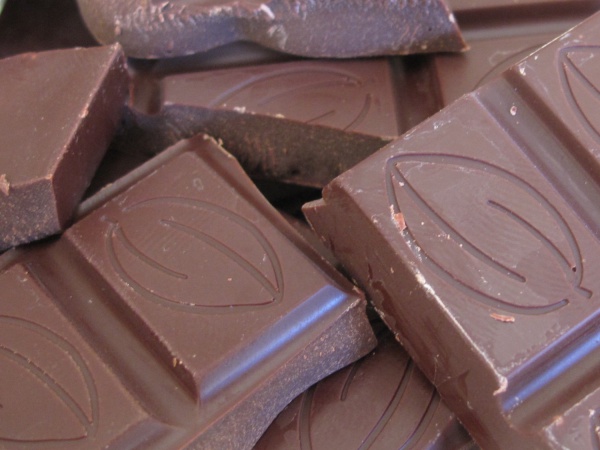
| ||
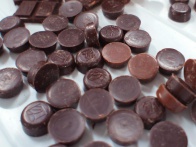 Milk and dark chocolate drops Milk and dark chocolate drops
|
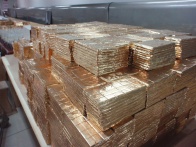 Wrapped chocolate bars Wrapped chocolate bars
|
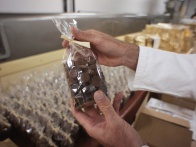 Gift-wrapped chocolate drops Gift-wrapped chocolate drops
|
Since 2006 Cinagra produces fine chocolate in a factory located on the outskirts of Antananarivo, about 15 kilometres from the city centre. 20 employees work in the factory, where its production facilities meet European standards. All processed cocoa beans originate from organic cocoa plantations in the northwest of Madagascar.
Cinagra differentiates between superior cocoa beans used for export and standard cocoa beans used for the local market. All cocoa beans undergo a quality check at the factory. Thereafter the cocoa beans are roasted for 50 minutes to bring out the chocolate flavour and colour. After cooling down the beans are cracked, separating the hard outer shell from the cocoa nib. At the same time, the nibs are sorted by size and thereafter crushed in a grinding machine. The crushed nibs are mixed with other ingredients, such as cocoa butter, soya lecithin, sugar, milk powder and vanilla. This chocolate mixture undergoes the process of kneading and agitating in a conching machine for 72 hours non-stop. After finishing the chocolate mixture is stored at 44°C until further processing. Depending on the final type of chocolate, a tempering machine adjusts the chocolate mixture to the necessary temperature (29°C for milk chocolate and 31°C for dark chocolate). The chocolate is now ready to be filled into bar forms or various theme forms. A cooling tunnel chills the chocolate slowly down to 4°C at the end of the process. The individual wrapping of the chocolate is made by hand.
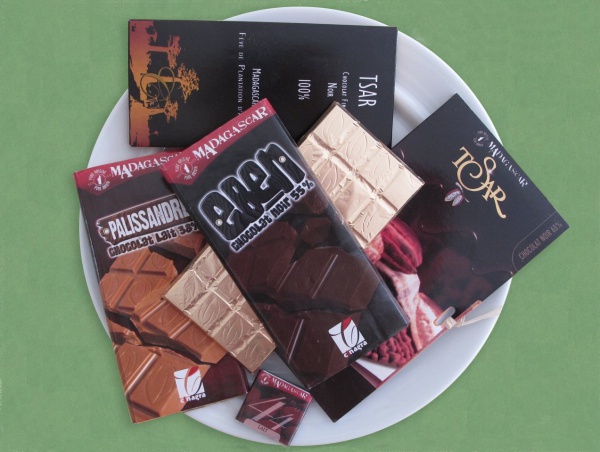
| |||
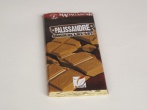 Palissandre (80g) Palissandre (80g)
|
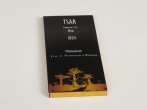 Tsar Noir (75g) 100% Tsar Noir (75g) 100%
|
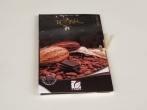 Tsar (80g) 63% Tsar (80g) 63%
|
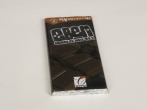 Eben (80g) Eben (80g)
|
Besides the various chocolate bars and cooking chocolate sold in super markets and shops throughout the country, Cinagra also supplies confectioneries, such as Chocolaterie Colbert, with so-called industrial chocolate. The dark chocolate bars named Eben and Tsar have between 55% and 100% of cocoa, the milk chocolate bars such as Palissandre vary between 38% and 44% in cocoa. One of their latest products is Tsar with 72% cocoa, flavoured with chocolate nibs and Fleur de Sel (sea salt). In 2009 Cinagra won the 1st price at the international chocolate competition Salon du Chocolat de Paris with their dark Tsar chocolate (63% cocoa).
Contact information
Chocolaterie CINAGRA
II M35GF
Androhibe / Analamahitsy
BP 4101 / Antananarivo 101
Madagascar
Tel: +261 (0)20 22 535 23
Fax: +261 (0)20 22 535 24
Email: contact@cinagra.com
